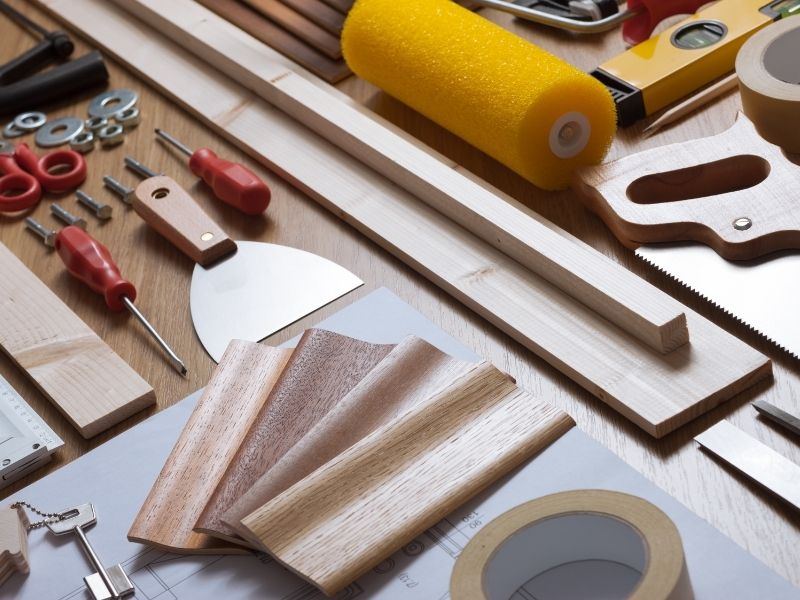When discussing DIY projects vs. professional, first, you must understand the difference between DIYs, home renovations, and home remodeling. All three of these sound similar, but they’re actually very different. DIYs can be done by anyone, and so can most home renovations. Remodels, however, are usually only done by professionals.
This article will briefly discuss different types of home improvement projects that can be done by the homeowner, projects that should be done by professionals, and which professionals to call to do certain projects. If you have trouble deciding how to proceed on your home projects, continue reading to learn about DIY projects vs. professional.
Home Improvements • DIY Projects vs. Professional

DIY vs. Renovation vs. Remodel
⎆ DIY: Do It Yourself
Home DIY projects include things like painting walls or furniture, creating or upholstering a headboard, adding shelves to walls or building your own bookshelf, designing a wreath for your front door, creating your own paintings for your walls, and many more. Like the name says, DIY projects are the projects that you can do yourself.
⎆ Renovations
Home renovations can also be done yourself, but they require a little more skill. To renovate means to revive, and you can revive anything in your home from the paint on the walls to the roof on your house. Roofing, however, requires a little more skill than other renovations, so it’s a renovation that requires a professional.
⎆ Remodels
Home remodels are when you completely change the state of a room, often altering its entire purpose. An example would be tearing down the wall that separates your kitchen and living room to create an open-concept room. Another example would be adding an additional room to your home. These projects almost always require a professional.
The Professionals
⎆ General Contractors
A construction manager, or general contractor, is the person who is in charge of a construction project. They oversee the many tasks and activities that go into the construction of a home or other building. Because it takes a lot to construct a building, from design to the actual construction, general contractors hire other contractors (subcontractors) to help out with specific tasks.
⎆ Subcontractors
Subcontractors are the people that general contractors hire to do a specific job. They are not employees of the general contractor, but they do report to the general contractor rather than the client. When doing home remodels, you don’t have to hire subcontractors in addition to the general contractor.
⎆ Construction Workers
Examples of subcontractors in the construction field are carpenters, dry wallers, electricians, landscapers, plumbers, roofers, and the like. All of these jobs require a professional license, and a general contractor may hold a license in any of these areas.
⎆ Designers
Not exactly subcontractors, but interior designers and architects are some more professionals that general contractors will be working closely with. Architects are responsible for the entire foundation of a building project. They are the ones who design the outside structure, while interior designers design the inside. Interior designers aren’t just decorators of the inside, but they actually decide where certain structures (such as sinks and cabinetry) will be placed.
Materials Needed for Home Improvements.
When doing DIY projects for your home, it’s pretty easy to acquire the tools and equipment you’ll need to complete the project. DIYs don’t usually cost much, depending on the project. The price of renovation projects also depends on the type of project being done. Getting new tile for your kitchen and bathroom doesn’t usually cost as much as a new roof. Home remodels, on the other hand, tend to be the most expensive, and this is because you’re hiring professionals.
If you’re wanting to do the bigger projects, you’ll likely need to become a general contractor or at least be licensed to do the work you’re wanting to do. You’ll also need the proper building permits required to do home remodels. As a licensed contractor, you’ll have access to specialized tools, equipment, and even truck rental services that are limited to professionals.
In conclusion.
While you weight the pros and cons of DIY projects vs. professional, remember to never attempt major projects yourself without proper licensing and/or permits. Many types of home remodels are illegal without a permit and may result in a hefty fine. If you have any questions or suggestions, we always love to hear from you in the comments below. Also below are links to more interesting articles about ALL things DESIGN for your home or business.
Images Courtesy of Canva.
Other Posts You Might Enjoy:
DIY Tips and Tricks for a More Spacious Condominium
DIY Home Office: 5 Signs You Need a Desktop Replacement





